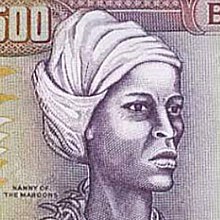
Back Böyük Nənə Azerbaijani Nanny of the Maroons German Nanny de los Cimarrones Spanish Nanny (Jamaïque) French रानी दाई (जमैका) Hindi グラニー・ナニー Japanese Kwiin Nani a di Maruun JAM Grandy Nanny Dutch Nanny of the Maroons NN Queen Nanny of the Maroons NB

Nanny of the Maroons | |
|---|---|
 | |
| Born | c. 1686 |
| Died | 1760 |
| Occupation | Leader of Jamaican Maroon community |
| Known for | 18th-century freedom fighter and leader |

Queen Nanny, Granny Nanny, or Nanny of the Maroons ONH (c. 1686 – c. 1760), was an early-18th-century freedom fighter and leader of the Jamaican Maroons. She led a community of formerly-enslaved escapees, the majority of them West African in descent, called the Windward Maroons, along with their children and families.[1] At the beginning of the 18th century, under the leadership of Nanny, the Windward Maroons fought a guerrilla war lasting many years against British authorities in the Colony of Jamaica, in what became known as the First Maroon War.
Much of what is known about Nanny comes from oral history, as little textual evidence exists. According to Maroon legend, Queen Nanny was born in 1686 and was an Asante from Asanteman, who was taken into slavery by the British.[2]
During the years of warfare, the British suffered significant losses in their encounters with the Windward Maroons of eastern Jamaica. Maroons attributed their success against the British to the successful use of supernatural powers by Nanny, while historians believe that the Maroons' mastery of guerrilla warfare and vast knowledge of the natural terrain played a significant role in their successes. Having failed to defeat them on the battlefield, the British sued the Maroons for peace, signing a treaty with them on 20 April 1740.[3] The treaty stopped the hostilities, provided state-sanctioned freedom for the Maroons, and granted 500 acres (202 ha) of land to Nanny and her followers. The village built through that land grant still stands, and is called Moore Town or the "New" Nanny Town. Modern members of Moore Town celebrate 20 April 1740 as a holiday, known informally in places today as "4/20" or "four-twenty".
In 1975, the government of Jamaica declared Nanny their only female national hero by celebrating her success as a leader.[4] Her image is printed on the Jamaican $500 note, which is referred to as a "Nanny".
- ^ Bilby, Kenneth M. (2005). True-born maroons. Gainesville: University Press of Florida. pp. 150–156, 454. ISBN 0813028736. OCLC 61821888.
- ^ Cudjoe of Jamaica: Pioneer for Black freedom in the New World by Milton C. McFarlane. ISBN 9780894900013 pages= 10 – 25
- ^ Gottlieb, Karla Lewis (2000). The mother of us all : a history of Queen Nanny, leader of the Windward Jamaican Maroons. Trenton, NJ: Africa World Press. p. 95. ISBN 0865435642. OCLC 38061550.
- ^ Zips, Werner (2011). Nanny's Asafo warriors : the Jamaican Maroons' African experience. Kingston: Ian Randle Publishers. p. 70. ISBN 9789766376659. OCLC 852941442.